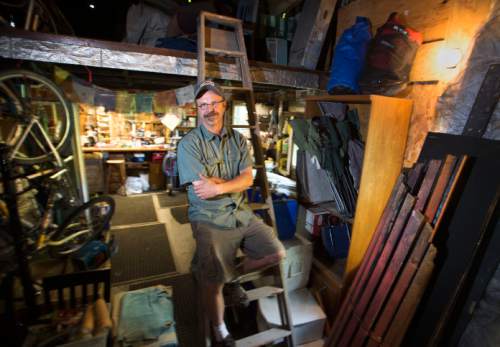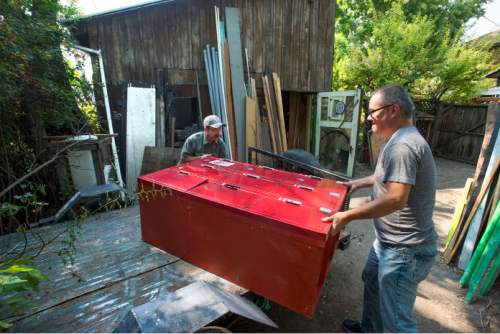This is an archived article that was published on sltrib.com in 2015, and information in the article may be outdated. It is provided only for personal research purposes and may not be reprinted.
Set designer Randy Rasmussen says he lives by creative visualization, imagining a set piece or a job, then finding the perfect fit.
He admits that sounds New Agey, but that artistic philosophy has served him well, whether he's pulling set elements for his Plan-B Theatre designs out of what he calls his Magic Barn or looking for a new job.
"If I need something, I thoroughly believe I can create it out of thin air by thinking about it hard enough," he says, with a laugh.
When he was restoring his 1902 Victorian house in the Trolley Square neighborhood, he often would find original design elements, such as French doors, in the property's outbuilding, which is really more shed than barn. When he was seeking set pieces for Plan-B or for his day job at Kingsbury Hall, he would often find the right piece deep in the bowels of his workshop, which is why he came to term the place the Magic Barn.
"That's where the magic happens," he says.
What puts the magic in the Magic Barn? "It seems that whenever we need something unusual, it magically appears from Randy's barn," is how Plan-B managing director Cheryl Cluff describes it.
After nearly 15 years as the Salt Lake City company's resident set designer, the Utah native has moved to Santa Fe to start a new job as technical director for the Lensic Performing Arts Center. Rasmussen still plans to work with Plan-B long distance, and his design aesthetic will be on display for the first two shows of the company's season, Eric Samuelsen's "The Kreutzer Sonata," which opens tonight (see related story on D1), and Rob Tennant's "Booksmart," which opens Dec. 3.
Rasmussen's design for Samuelsen's play illuminates the mind of the story's main character, Pozdnyshev, who also was the main character in Leo Tolstoy's novella, which was named after Beethoven's famed composition. A Steinway grand piano and a music stand for a violinist are set in front of giant strips of screen. "These are screens like you would find on a screen door, except these are 3 feet wide and 20 feet tall and play crazy tricks with light," says Jerry Rapier, the company's producing director.
Rasmussen designed the set to be acoustically transparent, as the musicians mostly rehearsed for the show in an empty room. "If they showed up and the acoustics were different, it would be the end of the fun," he says.
Creating minimalist theater with social messages suits Rasmussen's own artistic ambitions, while a decade attending the Burning Man Festival inspired his creative eye. "Song-and-dance theater isn't why I'm there," he says. "I want to see people onstage screaming and shouting and talking about real serious issues."
At 48, after spending most of his working life in Salt Lake City, Rasmussen felt that U.S. District Judge Robert J. Shelby's ruling in the case of Kitchen v. Herbert was a signifier that Plan B and other theater companies had sparked some change. That's what led him to think about moving on.
Rasmussen grew up in Sandy and got his start in theater playing Oberon in a 1982 production of "A Midsummer's Night Dream" at Jordan High School, where he was tapped to design the set. The historic high-school building had a real stage with a fly system, which might have been dangerous for students, but the facilities sparked his interest.
At Southern Utah State College — now Southern Utah University — he studied technical theater and art, and became friends with Tobin Atkinson and Cluff, who after graduation founded Salt Lake City's Plan-B Theatre Company.
He worked for seven years as a carpenter and set painter at Pioneer Theatre Company, and then a long stint as technical director at Kingsbury Hall, the University of Utah roadhouse.
At Kingsbury, Rasmussen learned how to make things happen very fast for touring shows. In the shop at Pioneer, he says he learned how to make theater well.
He drew upon both of those skill sets when he became the technical director at Plan-B, a mission-driven company aimed at producing socially conscious theater. It is one of the few companies in the country dedicated to producing whole seasons of works written by local playwrights.
At Plan-B, which rents its space at Rose Wagner Performing Arts Center, the schedule for load-in is tight. "I can go from an empty room to a show that's ready for rehearsal in four hours," Rasmussen says. "There's not a lot of people who could tell you that story."
His set designs are noted for their pared-down, almost impressionistic visual qualities. "Wonderful simplicity" is how Samuelsen explains Rasmussen's aesthetic. "Randy's great virtue as a designer is he understands the impact and power of simplicity."
He's able to take something really simple and make something very interesting with it, says Cluff, Rasmussen's longtime friend. "He definitely helped us really refine the less-is-more thing that we've got going on."
In the beginning, Rasmussen learned to create sets for only a few hundred dollars, because the company didn't have much money. Even as budgets grew, he liked the challenge of coming in way under budget.
He might be a master at recycling, but he's strategic about it. "The trick is to pull it off so your audience doesn't know," he says. "Everyone is into recycling until you show them the same thing twice.
For example, for last season's road-trip story, "A/Version of Events," Rasmussen molded plastic PVC around his own car — a 93 S-10 Blazer — to create the outline of a car's front seat.
The set cost $50 for a steering column, plus $10 in PVC connectors and maybe a $5 bottle of glue. "But I kinda doubt that, because I probably had that," he said with a laugh.
His design strategy, he says, was to put as little onstage as possible and still have the set read visually as a car. He intends for theatergoers to be involved in filling in the visual blanks, so they're participating in the show. "A/Version" playwright Matthew Ivan Bennett called the set "a sculpture in its own right," serving as a frame that created both "up-closeness and claustrophobia" for the story's two characters.
Later, in technical rehearsals, Rasmussen helped Bennett and the director and actors see how to work with the set. "He's so laid-back you never know if he's in the theater or not," Bennett says. "And then he sees things I don't see, down to the 5-degree angle — moving that car by 5 degrees — which opened up the blocking and let the audience see the actors' faces."
In an earlier play, Bennett wrote stage directions that spelled out the mind-body contrast he wanted visualized for "Di Esperienza," a play about the genius of Leonardo da Vinci. Rasmussen instead persuaded Bennett to spotlight Leonardo's drawings.
The character was himself a sketch, "that's what Randy saw," Bennett says, and through that metaphor the set designer changed the playwright's view of his own work. "Because of him, I realized I was writing about a person who wasn't done."
"Plan-B is great that way," Rasmussen says. "It's a place where people can freely contribute ideas. We're interested in finding the right idea, and not necessarily my idea."
About that Magic Barn and the 1902 Victorian house Rasmussen owns in the Trolley Square neighborhood? When he moved to New Mexico two months ago, he left them in the hands of a good friend who will rent the place for a time.
That means the theater company will still have access to Rasmussen's workshop and storage spot — and as a place of creative visualization for Rasmussen and others, such as longtime local set designer Keven Myhre, formerly at Salt Lake Acting Company, who will be working with Plan B next year.
Beyond his set design legacy, Rasmussen's visual talents live on locally in a mural at Gateway District's Rio Grande Cafe.
Some years ago, a friend of a friend bagged out on a commission to create a mural for the restaurant. The shape, 3 feet by 23 feet, was daunting for some artists, but not for a skilled set painter.
"I hesitate to call myself a fine artist, but I'm definitely a painter," and the size seemed to pose almost ordinary challenges for Rasmussen.
You can see his love of the outdoors in his vertical painting of the Book Cliffs, a swath of scenery near Green River and Price.
facebook.com/ellen.weist —
'The Kreutzer Sonata'
When • Sundays and Mondays, 7 p.m., through Nov. 9
Where • Rose Wagner Performing Arts Center's Studio Theater, 138 W. 300 South, Salt Lake City
Tickets • $20; 801-355-2787 or planbtheatre.org







